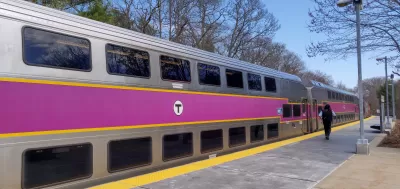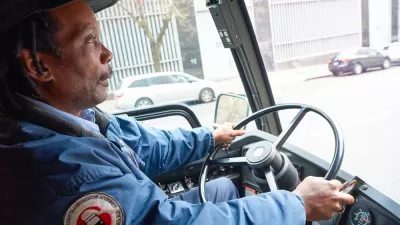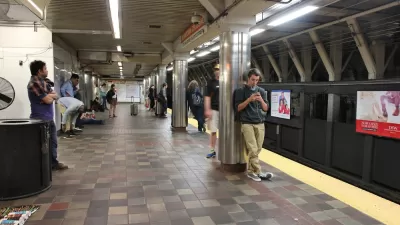Ridership on the region’s commuter rail reached 80 percent of pre-pandemic levels in March.

Transit ridership in the Boston area reached 68 percent of pre-pandemic levels in March of this year, the highest rebound since 2020, reports Bruce Mohl in Commonwealth Magazine.
The Massachusetts Bay Transportation Authority (MBTA) saw the biggest bounceback on commuter rail, which reached 80 percent of pre-pandemic ridership. “Even though ridership is ticking upward, fare revenue hasn’t budged much, remaining fairly stable since October 2022. For the first nine months of the current fiscal year, fare revenue was $276.3 million, down $75.3 million, or 21 percent, from what was forecasted.”
Mohl points to slow subway service as one reason why only 59 percent of riders have returned to that mode. “A fifth of the system is operating under slow zone rules because of defective track. At a meeting of the MBTA board of directors on Thursday, General Manager Phillip Eng said track work still has a long way to go but is showing signs of some progress, with some slow zones being eliminated and others converted to slightly higher speeds – say, 10 miles per hour to 25 miles per hour.”
Mohl explains, “Addressing the slow zones is contingent on getting repair workers to the track, a process that has been slowed by the T’s failure to develop a safety plan for rail work.” After a first draft was rejected by the Federal Transit Administration (FTA), the MBTA submitted a revised safety plan last week.
FULL STORY: MBTA ridership hits highest level since pandemic began

Trump Administration Could Effectively End Housing Voucher Program
Federal officials are eyeing major cuts to the Section 8 program that helps millions of low-income households pay rent.

Planetizen Federal Action Tracker
A weekly monitor of how Trump’s orders and actions are impacting planners and planning in America.

Ken Jennings Launches Transit Web Series
The Jeopardy champ wants you to ride public transit.

Washington Legislature Passes Rent Increase Cap
A bill that caps rent increases at 7 percent plus inflation is headed to the governor’s desk.

From Planning to Action: How LA County Is Rethinking Climate Resilience
Chief Sustainability Officer Rita Kampalath outlines the County’s shift from planning to implementation in its climate resilience efforts, emphasizing cross-departmental coordination, updated recovery strategies, and the need for flexible funding.

New Mexico Aging Department Commits to Helping Seniors Age ‘In Place’ and ‘Autonomously’ in New Draft Plan
As New Mexico’s population of seniors continues to grow, the state’s aging department is proposing expanded initiatives to help seniors maintain their autonomy while also supporting family caregivers.
Urban Design for Planners 1: Software Tools
This six-course series explores essential urban design concepts using open source software and equips planners with the tools they need to participate fully in the urban design process.
Planning for Universal Design
Learn the tools for implementing Universal Design in planning regulations.
Heyer Gruel & Associates PA
Ada County Highway District
Institute for Housing and Urban Development Studies (IHS)
City of Grandview
Harvard GSD Executive Education
Toledo-Lucas County Plan Commissions
Salt Lake City
NYU Wagner Graduate School of Public Service





























